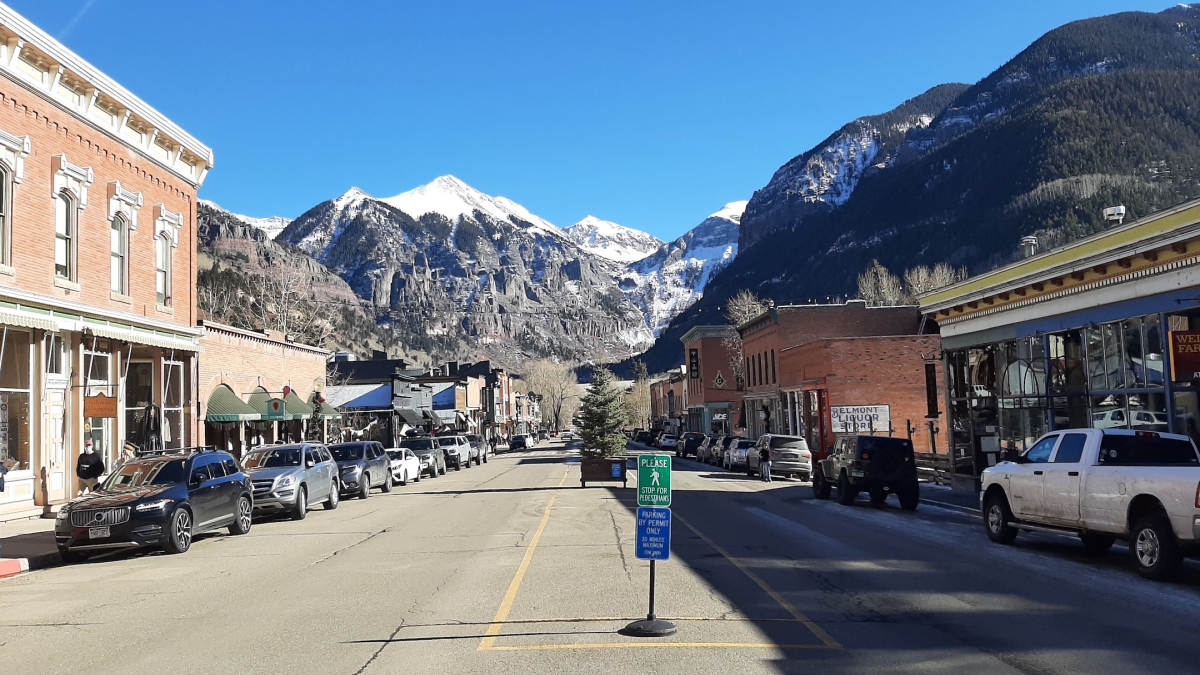Blizzards in Hawaii.
No snow in the Colorado Rockies.
Crickets in Ketchum, Idaho.
What in the world is going on in the West?
Some say that climate change has affected this year’s winter in the Western region of the country, while others are wondering what the lack of snowpack might mean for regional water supply, which is already in a precarious state.
ASU News enlisted the state’s climatologist and a tourism expert to discuss this year’s cause and effects of snow, or lack thereof, and the impacts to our water supply and economy.
Arizona State Climatologist Erinanne Saffell is a lecturer in the School of Geographical Sciences and Urban Planning at Arizona State University. Her main research interests are extreme weather and climate events, including flood and drought, as well as impacts of the urban heat island.
Nicholas Wise is an assistant professor in the School of Community Resources and Development, and his work focuses on focuses on placemaking, competitiveness, social regeneration and community impacts, conducting work across the areas of sport, events and tourism.
Here are their thoughts on what happens when weather does not follow the expected forecast.
Erinanne Saffell
Question: All across the West and Southwest, we’re seeing some interesting weather patterns: blizzards and flooding in Hawaii and no snow in the Rockies and several ski resort towns. Is this just a weather fluke, or is something else going on?
Erinanne Saffell: As a climatologist, I consider the context of weather patterns. For example, Mauna Loa and Mauna Kea on the Big Island of Hawaii are each well over 13,000 feet in elevation and receive snow every year. A blizzard is not an unusual weather situation for the peaks, but it would be unusual if a blizzard happened on Waikiki Beach. Blizzards and flooding in Hawaii are often experienced during a low-pressure system called the Kona Low that usually sets up between October and April. A similar setup happened Dec. 1–7, 2007, with flooding, power outages and blizzard warnings on the Big Island of Hawaii.
The current pattern in the Western U.S. is largely being influenced by La Niña. La Niña tends to move storm tracks to the northern tier of the U.S., which means the Lower Colorado River Basin typically receives less winter precipitation. Both La Niña and El Niño can influence precipitation in the West. For example, a weak El Niño pattern was operating during the winter of 2018–19, and the Rocky Mountains received record amounts of snow. In fact, the Arapahoe Basin in Colorado stayed open for two extra weeks of skiing in July 2019.
Q: We know the impacts of a drier season in Arizona, but how does this affect places like Ketchum, Idaho, or the Colorado Rockies, places that historically get a lot of snow?
Saffell: While La Niña tends to make Arizona’s winter warmer and drier, it can often help mitigate drought in the Pacific Northwest. Overall, drought in the Western U.S. was exceptional in 2021. Warmer and drier conditions stress vegetation in forests, making them susceptible to infestation and wildfire. Wildfires need fuel and a trigger, like lightning or embers from a campfire. It’s important to recognize that wildfire is a natural part of many ecosystems in the West. For example, several conifers require wildfire to germinate. Fire as a natural process clears brush and seedlings and contributes nutrients to the soil. Unfortunately, forests are now more dense and wildfires are burning hotter from the added fuel. What could have been a natural brushfire can easily speed out of control as a dangerous crown fire, leading to burn scars and dangerous debris flows.
Q: Arizona has officially been in a drought since 2000, affecting about 75% of our state land. What is going on?
Saffell: Some years are wetter than others, but the overall trend since the mid-1990s has been below-average statewide precipitation. Drought is assessed on both short-term and long-term timescales, and there are different types of drought. Long-term hydrological drought is largely what we see along the Colorado River. Meteorological drought is based on precipitation, and this past summer, a very active monsoon season was able to mitigate some of the meteorological and ecological drought across the state.
Ecological or agricultural drought identifies implications to the ecosystems, including soil moisture and vegetation. Precipitation in arid and semi-arid climates is always highly variable, but another aspect of drought is temperature. A warmer atmosphere is a thirstier atmosphere, forcing more evaporation from surfaces. Warmer temperatures also affect the types of precipitation. Arizona and the Western U.S. depend on winter snowfall to recharge reservoirs and groundwater. As temperatures increase, winter snowfall decreases, impacting our water supply.
Q: As the new Arizona state climatologist, what is it that you will be doing in your job and what are you hoping to accomplish?
Saffell: I’m the sixth state climatologist for Arizona, and I believe I’m the only Arizona state climatologist that was born and raised in Arizona. I was appointed by Gov. Doug Ducey, but I don’t directly advise policy. Instead, I support climate services across the state. For example, I’m co-chair of the Arizona Department of Water Resources Drought Monitoring Technical Committee, where we evaluate Arizona’s level of drought and make recommendations to the weekly Drought Monitor. Our advisory group just provided our annual report to the governor, recommending that Arizona continues its drought declaration.
I’m the director of the Arizona State Climate Office, which is supported by the School of Geographical Sciences and Urban Planning through The College of Liberal Arts and Sciences. ASU has supported the Arizona state climatologist since 1973, when the position moved from the National Weather Service to the states. My office engages and builds relationships with various stakeholders, and we support researchers, private companies, government agencies and the general public.
Q: What do you want people to understand about climate?
Saffell: Everyone is continuously surrounded by weather and climate, and I think it’s helpful to understand how these processes operate. I talk to community groups at all ages and levels, and one of the ideas I like to explain is how our hottest temperatures don’t usually happen until later in the afternoon, even though the sun is the highest around noon. I also think it’s important to understand the urban heat island because the Phoenix metropolitan area has one of the most extreme urban heat islands in the world. The urban heat island impacts everyone living in the metropolitan region, and the consequence is that our nighttime temperatures are warming. People tend to increase their air-conditioning usage at night. Learning how the urban heat island operates helps folks understand how they might mitigate the heat load on their own house, perhaps by planting shade trees or installing shutters on their windows.
Nicholas Wise
Q: The Colorado Rockies and many ski towns that usually get snow haven’t seen any yet. How does that impact tourism in places that accommodate skiers and people looking to spent time in a wintry setting?
Nicholas Wise: A lack of snow at this time of year can do two things: It can delay the early start of tourism centered around skiing or snowboarding, or it can cause concern among prospective travelers who may reconsider booking travel later. At the moment this can essentially delay the season — the snow slopes for skiing, snowboarding and other winter activities are central to tourism in Colorado from as early as late October to generally around early April.
I took a road trip over the Thanksgiving holiday, and one of my stops was in Telluride, Colorado. Like most, I was anticipating more snow, but the town and much of the mountain landscape was generally dry, with just some remaining ice and snow in the north shadows that the sun couldn’t melt. The challenge is without the wintry setting, what I observed was many businesses and restaurants were not open, and I suspect might be delaying opening until later than intended. The ones that were open were very busy and had long wait times for lunch. ... Seasonality is a great challenge for destinations, and if something is disrupted, then this will have community and economic implications.
While in Colorado they depend on snow in the winter, tropical destinations in the Caribbean are at the mercy of hurricanes and tropical storms that can disrupt their prime tourism season, and too much rain in the summer in the Mediterranean can disrupt the season — so in many respects the economic success of a destination is tied to the climate and weather trends and patterns in any given year. This has implications not only on money into a destination, but on jobs, of people who work directly with tourists and jobs linked to the local and regional supply chain.
Q: Can you give us an idea in terms of dollar amount what that means and what types of businesses are affected?
Wise: Estimates in sources like Power magazine mention that a lack of snow in a given wintry tourism season can see ski towns experience revenue losses of $1 billion and a loss of more than 17,000 jobs. It is difficult to place a specific dollar amount, but let’s try and break this down. So let’s say a couple, family or a group of friends are paying say $80 to $300 (or more) a night in accommodation, you can easily spend $50 on lunch for two people, and more than that again on dinner. People stop and buy souvenirs and T-shirts, and that is easily $120-plus spent among a few people, so that restaurants, hotels, shops are highly dependent on the season for business income and to be able to keep employees regularly employed. Then there is the lift tickets that people pay, which you pay more than $100 for, and the rental/repair/equipment supply shops also see less business.
This all adds up, and if a couple, family or group of friends decide against taking that ski or snowboarding trip to Telluride, then that $300 (but often much more depending on how one spends) spent each day is not being brought in, and that is just for accommodation, food and a lift ticket. There are also flight costs, rental cars, fuel and of course beverages of choice and other recreational options than one can decide to purchase in Colorado.
Q: If there is a lack of snow and water in these towns, what is your long-term forecast for these places?
Wise: This discussion is especially pressing this year, but climatologists also point to long-term concerns that we need to consider. Let’s consider the immediate reasons why we are discussing this: La Niña, which we are experiencing now and which we also experienced last year. The linked map from climate.gov and the National Oceanic and Atmospheric Administration show that a blocking high-pressure system over the Pacific means less moisture moving across the continent. The places that do traditionally see high levels of precipitation, such as the Pacific Northwest and the Great Lakes, experience even more precipitation, and wet weather tends to also concentrate here. The variable polar jet stream is also important to look at, and when we move east of the Cascades of the Northwest we get into a rain shadow, and north of this variable polar jet stream it is feeling colder than usual.
La Niña impacts the Southwest in another way, and with it being drier it also makes it feel warmer than usual. For instance on Dec. 1 this year, we experienced the warmest temperature for this date in record-keeping history, and we experienced 25 days in November over 80 degrees Fahrenheit. Looking at the map, dry air and above-normal temperatures are causing a lack of snow in ski towns in Colorado, Utah, Wyoming and Idaho. Closer to home, this can have an impact as well on our ski destinations in northern Arizona. The long-term forecasts are important to consider and are where many point to concerns and even the shortening of the wintry season in places that depend on skiing, snowboarding and winter activities.
NASA is evaluating data and predicts that by the end of the 21st century we can expect the temperature to rise between 2 and 6 degrees Celsius. This can mean two things: It is possible we may see increased snowfall amounts, which can create challenges for transport and hazards that disrupt travel and recreation, such as avalanches. Alternatively, these warmer temperatures in the winter mixed with moisture in the air could mean rain instead of snow.
Q: In the case of a town that has built its economy around snow, what can it do to lessen those impacts?
Wise: Towns and destinations that have built economies around snow will experience disruptions when climate conditions change, such as what we see recently with La Niña. If the wintry season shortens, then destination managers need to strategize and work with businesses to find creative solutions. Many mountain destinations have found ways to extend the tourism season — winter activities dominate the image of these places, but the summer environment allows for hiking or skate-to-ski, but these can cause other environmental issues if not closely regulated.
Mountains are an incredible resource for a destination with and without snow, and destination marketers in collaboration with businesses and investors can consider spas and natural-healing retreats, or cultural or music events and festivals. The scenery and aesthetics of mountain settings supplemented by alternative tourism activities represent creative ways for destinations to attract visitors and also maintain jobs, to diversify the economy and find ways to overcome seasonality. In some of my past collaborative research in mountainous and coastal destinations we have researched ways and worked with destination managers to understand how destinations are combating seasonality and using heritage, sports and/or events to transform places.
Top photo: Main Street in Telluride, Colorado, with little to no snow on the mountains. This year's winter is getting a later-than-usual start, delaying ski season — which typically starts in late October or November. Photo courtesy of Nicholas Wise
More Environment and sustainability

Charles Redman, founder of the School of Sustainability, faces a new adventure: Retirement
At the retirement celebration for Charles Redman on Oct. 22, two messages persisted: Redman’s contributions to Arizona State University helped to shape the interdisciplinary efforts we now find…

10 climate insights to guide our future
A group of globally renowned social, natural and climate scientists has once again convened to offer their newest annual synthesis report, “10 New Insights in Climate Science.”The report, published…

The future is green: Job demand translates to high employability for ASU sustainability grads
A 2023 report by Forbes on the state of green jobs confirmed what Arizona State University has been trumpeting for years: Sustainability will play a large part in the new economy.The report suggests…


